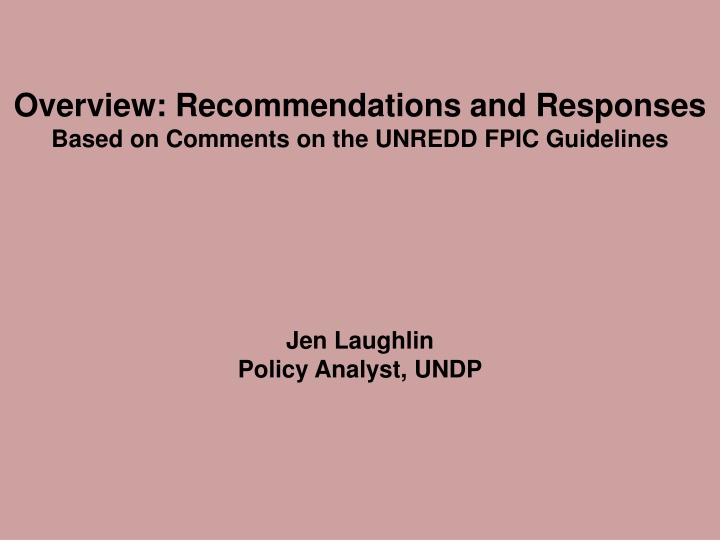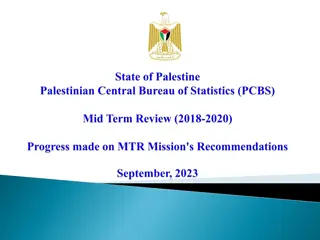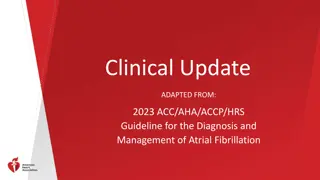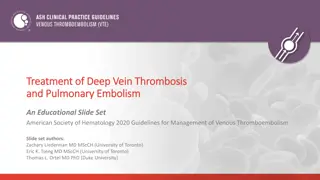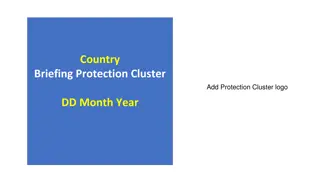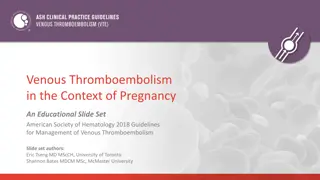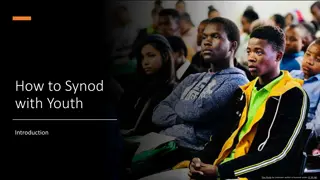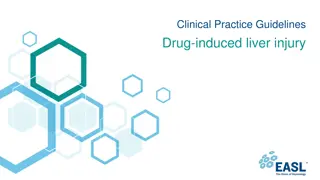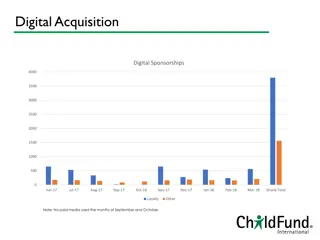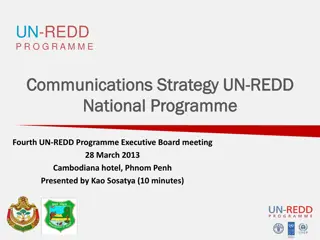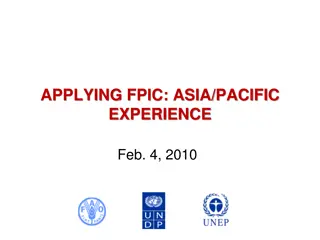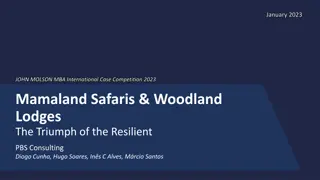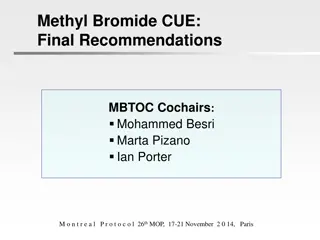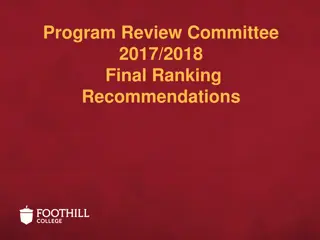Recommendations on Tailoring UNREDD FPIC Guidelines
Enhance the normative framework, address differing standards, incorporate gender perspectives, and clarify guidelines for seeking FPIC within national contexts. Various stakeholders provided feedback on the UNREDD FPIC Guidelines, suggesting strengthening Section 1.3 and ensuring clarity on consent processes, accountability mechanisms, and scope of application.
Download Presentation

Please find below an Image/Link to download the presentation.
The content on the website is provided AS IS for your information and personal use only. It may not be sold, licensed, or shared on other websites without obtaining consent from the author.If you encounter any issues during the download, it is possible that the publisher has removed the file from their server.
You are allowed to download the files provided on this website for personal or commercial use, subject to the condition that they are used lawfully. All files are the property of their respective owners.
The content on the website is provided AS IS for your information and personal use only. It may not be sold, licensed, or shared on other websites without obtaining consent from the author.
E N D
Presentation Transcript
Overview: Recommendations and Responses Based on Comments on the UNREDD FPIC Guidelines Jen Laughlin Policy Analyst, UNDP
List of Commenters NGO / Academia CARE Lima Center for International Forestry Research (CIFOR) Conservation International (CI) University College London (UCL) University of Dalat, Viet Nam Federation for the Self -Determination of Indigenous Peoples (FAPI), Paraguay Forest Peoples Programme (FPP) Gaia Commoditas, Indonesia Gender Action, Washington, DC Global Witness HuMa - Association for Community and Ecologically- based Legal Reform, Indonesia Indian Law Resource Center (ILRC) Indigenous Peoples of Africa Coordinating Committee (IPACC), Kenya Lao PDR GIZ- CliPAD Project Programa de Mudan as Climaticas - Climate Change Program Instituto de Pesquisa Ambiental da Amaz nia (IPAM) Rainforest Foundation Norway (RFN) RECOFTC The Center for People and Forests The Nature Conservancy (TNC) Stakeholders consultation, DRC Government Brazil (Funda o Nacional do ndio, Brazilian Federal Agency for the protection of indigenous peoples' rights (FUNAI)) Guatemala (Climate Change Unit, Ministry of the Environment and Natural Resources (MARN)) Norway Ecuador (Ministry of Environment) UN-REDD National Programme UN-REDD Programme, Indonesia UN-REDD Programme, Viet Nam Intergovernmental Body BDP/RBLAC Regional Expert, UNDP GEF/UNDP Small Grants Programme Indigenous Peoples and Minorities Section, OHCHR Kenn Rapp and Haddy Sey, World Bank UNDP DGG Anti-Corruption Team UNDP DGG - Human Rights Team UNDP Paraguay UN Permanent Forum on Indigenous Issues UN-REDD Regional Coordinator, Asia/Pacific, UNEP World Health Organization (WHO) Workshop of UN-REDD RTAs
Overview of Key Recommendations Needs to be tailored to national contexts Strengthen Section 1.3 (normative framework) Who gives consent? When is FPIC required? Process for Seeking FPIC Address differing standards (FCPF & UN-REDD) Grievance and accountability mechanisms Incorporate gender perspective
Key Recommendations and Initial Responses There should be clarity on how the Guidelines will be tailored to national contexts Section 1.3 (normative framework) of the Guidelines should be strengthened The scope of application of the Guidelines should be clearer in countries supported by both FCPF & UN-REDD The Guidelines need to elaborate on the proposal for grievance and accountability mechanisms The Guidelines should be reviewed and revised from the gender perspective
Key Recommendations to be discussed in Breakout Groups Who gives consent? Extend FPIC to non-IPs, but provide clarity on how to determine which groups FPIC should be extended to Stakeholder terminology should be: better defined; made consistent throughout the document; and tailored to national contexts Provide further guidance on how rights-holders will be represented in FPIC processes When is FPIC required? Clarify which activities require FPIC Clarify to what extent FPIC is required in the REDD+ Readiness phase Process for Seeking FPIC Clarify the methodology for evaluation/verification of an FPIC process Provide more guidance on the role of the facilitator in the FPIC process Clarify what is reasonable regarding FPIC process timeline
Who Gives Consent? Recommendation: Extend FPIC to non-IPs, but provide clarity on how to determine which groups FPIC should be extended to Stakeholder terminology should be: better defined; made consistent throughout the document; and tailored to national contexts Possible way forward -- The Guidelines: Should state more explicitly the difference in rights between IPs and non- IPs (based on relevant international law) Could include criteria to support National Programmes to determine which groups FPIC should be extended to; and guidance on undertaking a national rights-holder mapping exercise Questions: What should be the criteria for determining which groups FPIC should be extended to (i.e modernity/traditional lifestyle, dependency on forest resources, or historic, social and cultural ties to the (forest) area)? How should the Guidance deal with situations where States do not recognize the distinct identity and rights of indigenous peoples?
Who Gives Consent? Recommendation: Provide further guidance on how rights-holders will/should be represented in FPIC processes Challenges: Some communities may not have representative structures Difficult to distinguish between those claiming to represent others and those that genuinely do Not all representative processes/structures are transparent or democratic Given the diversity and quantity of IP and other rights-holders groups in some countries, how would a national-level FPIC process take place? Questions: What should be the criteria for determining the validity of groups claiming to be relevant rights-holders ? What level of representation is sufficient in an FPIC process (village, community, many communities, self-elected regional/national platforms?) How can National Programmes support or facilitate rights-holders to identify and/or create their own representative structures?
When is FPIC required? Recommendations: Clarify which activities require FPIC Clarify to what extent FPIC is required in the REDD+ Readiness phase Possible way forward: Develop criteria/questions to support National Programmes to determine whether or not an activity requires FPIC Questions: What criteria/questions could support a National Programme to determine whether or not an activity requires FPIC? Who determines whether the proposed activity/policy will significantly impact on land and what methods will be used for this determination-- will it be consultation, or social assessment or other methodologies? To what extent should the Guidelines prescribe when FPIC is required? Do readiness activities (and therefore UN-REDD NPs) require FPIC? What aspects (if any) of the development of a national REDD+ strategy require FPIC? Should consent be required at the national level or only at the community level? (If national, how should (all relevant) rights-holders be represented?)
Clarify components of Section 4 on Operational Framework for Seeking FPIC Clarify the methodology for evaluation/verification of an FPIC process What types of indicators and verification methods might be required to ensure an FPIC process was carried out in line with the elements as defined in Section 2? What criteria could guide the identification of an independent verification institution? Provide more guidance on the role of the facilitator in the FPIC process What criteria could guide the identification of a facilitator (e.g. independent, objective, acceptable by both parties, and able to work with various stakeholders)? Who will identify, select, and recruit the facilitator? Clarify what is reasonable regarding FPIC process timeline What level of flexibility should be given to the IPs/rights-holders timeline for decision making? How would a NP be guided to address what is an unreasonable timeline ?
